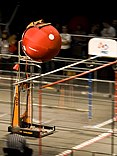
FIRST Frenzy: Raising the Bar was the 2004 game for the FIRST Robotics Competition. The game included elements from previous years' games, including mobile goals, "capping" goals with large inflatable balls, and others. In Raising the Bar, teams could score by having their human player score purple balls in any of the goals, capping the goals with a multiplier ball, or hanging their robot suspended from the 10-foot (3.0 m) high 'chin up bar'. In the qualifying matches, Teams competed in 2-member randomly generated alliances. In the elimination rounds, 3-member alliances competed against each other with one team sitting out each match. The alliance that won two matches advanced in the tournament.

Stack Attack was the game for the 2003 FIRST Robotics Competition. Two teams of two robots compete by moving large Sterilite bins into their zones and arranging them into stacks.

FIRST Robotics Competition (FRC) is an international high school robotics competition. Each year, teams of high school students, coaches, and mentors work during a six-week period to build robots capable of competing in that year's game that weigh up to 125 pounds (57 kg). Robots complete tasks such as scoring balls into goals, hanging on bars, placing objects in predetermined locations, and balancing robots on various field elements. The game, along with the required set of tasks, changes annually. While teams are given a kit of a standard set of parts during the annual Kickoff, they are also allowed and encouraged to buy or fabricate specialized parts. FIRST Robotics Competition is one of five robotics competition programs organized by FIRST, the other four being FIRST LEGO League Discover, FIRST LEGO League Explore, FIRST LEGO League Challenge, and FIRST Tech Challenge.
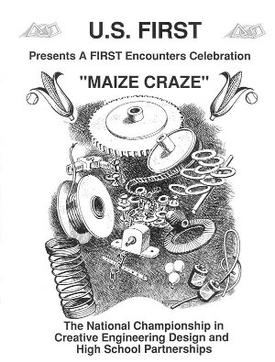
Maize Craze was the game in the inaugural year, 1992, of the FIRST Robotics Competition. This game was played by four individual robots trying to collect tennis balls into their starting base. An impediment to the robots was that the entire playing field was covered in a layer of corn 1-2 inches thick.

Rug Rage was the 1993 game of the FIRST Robotics Competition. In it, teams competed individually to score as many balls as possible in their goal.
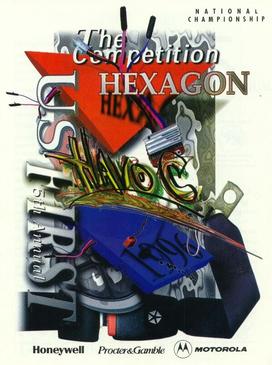
Hexagon Havoc was the 1996 game for the FIRST Robotics Competition. Seeding games of 1-on-1-on-1 were played double-elimination to determine the teams for the finals rounds. In the finals, robots played 1-on-1 in a best 2 out of 3.

Ladder Logic was the game for the 1998 FIRST Robotics Competition.

Double Trouble was the 1999 game for the FIRST Robotics Competition, and the first game to feature alliances.
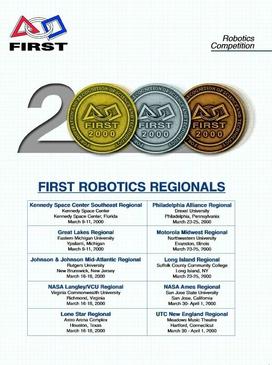
Co-Opertition FIRST was the 2000 game for the FIRST Robotics Competition.
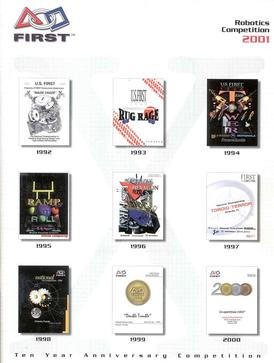
Diabolical Dynamics was the 2001 game for the FIRST Robotics Competition.

Lunacy is the game for the 2009 FIRST Robotics Competition. Announced on January 3, 2009, the name and some of the features of the game honor the 40th anniversary of the first human mission to the Moon. It is FRC's 18th game. This is the first FRC competition to use the cRIO Mobile Device Controller control system from National Instruments. The driver station introduced for 2009 was the Kwikbyte DS, which was replaced in 2010 by the Classmate PC.
Breakaway is the game for the 2010 FIRST Robotics Competition, announced on January 9, 2010. Robots direct soccer balls into goals, traverse "bumps" in the field, suspend themselves and each other on towers, and/or go through a tunnel located in the center of the field.

Logo Motion is the 2011 FIRST Robotics Competition game. Playing pieces are inner tubes shaped like the components of the FIRST logo. The primary objective of the game is to place them on racks to gain points. In the endgame, robots deploy smaller robots ("minibots") to climb a tower. Minibots must be made from the FIRST Tech Challenge kit of parts. The game celebrates the 20th season of the FRC and is also meant to commemorate the artist Jack Kamen, who designed the original FIRST logo.

Ultimate Ascent was the 2013 FIRST Robotics Competition game. It is styled similarly to disc golf.
FIRST Stronghold was the 2016 FIRST Robotics Competition game. The game was played by two alliances of up to three teams each, and involves breaching the opponents’ defenses, known as outer work as well as capturing their tower by first firing "boulders" at it, and then surrounding or scaling the tower using a singular rung on the tower wall. Points were scored by crossing elements of the tower's outer works, shooting boulders into the opposing tower's five goals in order to lower the tower strength, and by surrounding and scaling the tower.

FIRST Steamworks, stylized as FIRST STEAMworks, was the FIRST Robotics Competition game for the 2017 season. As in past games, two alliances of three individual teams and their robots compete on a field to score "match" point to win the game and ranking points to advance to playoff rounds. The game has a steampunk theme and teams are required to shoot wiffle balls which represent fuel into a simulated boiler which transfers the generated steam into an airship in the middle of the field. Each alliance has one airship, which they pressurize with steam from the boiler and load with plastic gears from the field. At the end of the match, robots can climb and hang on team-supplied ropes attached to the airship for additional points.
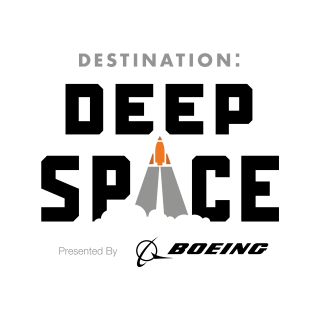
Destination: Deep Space, stylized as DESTINATION: DEEP SPACE and officially known as Destination: Deep Space Presented By The Boeing Company, is the FIRST Robotics Competition game for the 2019 season. It involves two alliances of three teams each, with each team controlling a robot and performing specific tasks on a field to score points. The game centers around an outer space theme involving two alliances consisting of three teams each competing to place poly-carbonate hatch panels and orange rubber balls or "cargo" on rockets and cargo ships before returning to their HAB platform to climb at the end of the match.

Infinite Recharge is the FIRST Robotics Competition (FRC) game for the 2020 season. The season is in partnership with Lucasfilm as part of its Star Wars: Force for Change initiative.

Rapid React, stylized as RAPID REACT and officially known as Rapid React presented by The Boeing Company for sponsorship reasons, is the FIRST Robotics Competition (FRC) game for the 2022 season. The game is themed around transportation as part of the FIRST-wide FIRST Forward theme for 2021-2022.

Charged Up, stylized as CHARGED UP and officially known as Charged Up presented by Haas for sponsorship reasons, was the FIRST Robotics Competition game for the 2023 season. The game is part of the FIRST-wide FIRST Energize theme for the 2022-2023 season, which focuses on energy and sustainable development. The season's kickoff event occurred on January 7, 2023, and was streamed live on Twitch.




















